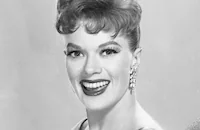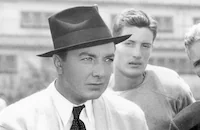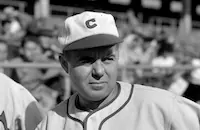The House Across the Street

Brief Synopsis
Cast & Crew
Richard Bare
Wayne Morris
Janis Paige
Bruce Bennett
Alan Hale
James Mitchell
Film Details
Technical Specs

Synopsis
When Villman, a witness who was to testify in the fraud trial of racketeer Keever, is killed while in the custody of the police, newspaper managing editor Dave Joslin writes several articles charging the police with incompetence. After Keever threatens Dave, J. B. Grennell, the paper's owner, who is worried about a libel suit, begs Dave to stop covering the story. Dave refuses and Grennell fires him. When Dave reminds him that he has a contract and cannot be fired, Grennell replies that Dave's contract has a clause that allows him to be re-assigned to any editorial position on the paper and names him the new "Dolly Trent," as the advice-to-the-lovelorn columnist is called. This news delights Kit Williams, who had been filling the position since failing to complete an assignment. Humiliated by the assignment, Dave quits. Later, Kit joins Dave in a local bar where he is getting very drunk. After accusing him of being a bad sport, she goads him into returning to work. One afternoon, a woman named Billie Martin comes to the paper to talk to "Dolly." She explains that she has had a fight with her boyfriend, Carl Schrader, who disappeared for a day and claims not to remember where he was during that time. When Dave learns that Carl had been drinking at Keever's nightclub, Horseshoe Harry's, he listens carefully to Billie's story and is even more interested to discover that Carl disappeared on the same day that Villman was killed. Dave questions Carl and then proceeds to the rooming house where Carl had regained consciousness. The manager refuses to talk to Dave, but a little girl named Madge remembers seeing a redheaded woman in a fur coat. Dave suspects that she is the same woman who was talking to Carl before he lost consciousness. Kit finds Dave's notes and decides to talk to Madge herself. Madge reveals that she overheard the redhead give the address "248" to the cab driver, but cannot recall the street. While she is questioning Madge, Kit is observed by Marty Bremer, one of Keever's men, who later tries to run her over. Bremer then decides to send Carl out of town. While Carl is packing, Kit and Dave arrive at his rooming house and Bremer hides in the kitchen during their conversation. Kit notices the half-packed suitcase and also spots Bremer's shadow on the wall. After she and Dave leave, she tells Dave what she saw. She then realizes that the address Madge heard must have been "240 8th." While Kit contacts the police, Dave proceeds to the address and learns that redheaded Beth Roberts lives there with Bremer. Later, Dave tells the police to look for a connection between Bremer and Carl. At Horseshoe Harry's, Dave spots a roving photographer and learns that she took a picture of Carl that night. Dave and Kit track down the negative and notice that in the background, Bremer is passing money to tough guy Eddie Macklin. Dave assumes that the money is payment to Macklin for killing Villman. Dave shows the picture to Carl, who remembers that he showed the photo to Bremer, who was sitting next to him at the bar, shortly before meeting Beth. Dave then uses the photograph to convince Bremer to testify against Keever. Keever is indicted, and Dave gets his old job back. Dave then tells Kit that she may either take back the Dolly Trent job or marry him, and she accepts his proposal.

Director

Richard Bare
Cast

Wayne Morris

Janis Paige

Bruce Bennett

Alan Hale

James Mitchell

Barbara Bates
James Holden
Ray Montgomery
Lila Leeds
Alex Gerry
Jack Wise
Eddie Foster

Charles Lane
Doreen Mccann
Zon Murray

Jack Mower
Ray Largay
Billy Mclean

Fred Kohler Jr.
George Chandler
Abe Dinovitch

Ray Walker

Phyllis Coates
Chick Chandler
Eddie Parks
Fred Kelsey

Billy Gray
Crew
G. W. Berntsen
Everett A. Brown
Roy Chanslor
Elmer Decker
Saul Elkins
Russell Hughes
William Lava
Frank Magee
Charles Maxwell
John Maxwell
Don Page
Hugh Reticker
William Snyder
Perc Westmore

Film Details
Technical Specs

Articles
The House Across The Street
By Richard Harland Smith

The House Across The Street
Quotes
Trivia
Notes
For more information on the three other Warner Bros'. films based on Roy Chanslor's story, for You Can't Escape Forever.














